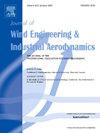侧风作用下风障结构对铁路桥梁周围流场的影响——基于新疆实际地形的研究
IF 4.9
2区 工程技术
Q1 ENGINEERING, CIVIL
Journal of Wind Engineering and Industrial Aerodynamics
Pub Date : 2025-09-19
DOI:10.1016/j.jweia.2025.106224
引用次数: 0
摘要
本文以新疆典型地形为例,介绍了一种新型风障对山区高速列车运行区域侧风影响的影响。采用非定常reynolds - average Navier-Stokes (URANS)方程结合非结构化六面体体积网格对跨尺度结构周围气流进行模拟,并通过风洞试验对模拟方法进行了验证。首先,试验结果证实了数值方法在跨尺度几何模型计算中的优势。其次,在典型地形基本模型(BMTT)中考察了桥梁上游的气流特性。结果表明,地形内存在多个高速带。值得注意的是,由于山谷影响的气流沿轨道方向向中心桥梁压缩,再加上地形和重力效应驱动的下坡风,桥梁高速区对列车安全构成了威胁。第三,对比了原始多孔改道壳体(OPC)和扩散改道壳体(DDC)的抗侧风性能,发现扩散改道壳体(DDC)在减小列车运行区域侧风影响方面更为有效。通过使气流向上和向下偏转,DDC在轨道1和2区域形成逆流区。它阻挡了86.7%的侧风,使74.1%的侧风远离了列车运行区域,使风障性能提高了44.2%。本文章由计算机程序翻译,如有差异,请以英文原文为准。
Impact of wind barrier structures on the flow field around railway bridges under crosswind: A study based on real terrain in Xinjiang, China
This paper presents the influence of an innovative wind barrier designed to mitigate the effects of crosswinds on high-speed train operating areas in mountainous regions based on typical terrain in Xinjiang, China. The study employs the Unsteady Reynolds-Averaged Navier-Stokes (URANS) equations combined with an unstructured hexahedral volume mesher to simulate airflow around cross-scale structures, and the simulation method has been validated through wind tunnel tests. First, the test results confirm the numerical method's advantage in cross-scale geometric model computations. Second, this paper examines airflow characteristics upstream of the bridge in the basic model of typical terrain (BMTT). Results show multiple high-velocity zones within the terrain. Notably, the bridge high-speed zones pose a risk to train safety, caused by valley-influenced airflow compression toward the central bridge along the rail direction, combined with downhill winds driven by terrain and gravity effects. Third, comparing the anti-crosswind performance of the original porous case (OPC) and the diffusible diversion case (DDC) reveals that the DDC is more effective in reducing crosswind effects on train operating areas. By deflecting airflow upward and downward, DDC creates reverse flow zones at tracks 1 and 2 regions. It blocks crosswinds over 86.7 % of its area and diverts 74.1 % of crosswinds away from train operating areas, enhancing wind barrier performance by 44.2 %.
求助全文
通过发布文献求助,成功后即可免费获取论文全文。
去求助
来源期刊
CiteScore
8.90
自引率
22.90%
发文量
306
审稿时长
4.4 months
期刊介绍:
The objective of the journal is to provide a means for the publication and interchange of information, on an international basis, on all those aspects of wind engineering that are included in the activities of the International Association for Wind Engineering http://www.iawe.org/. These are: social and economic impact of wind effects; wind characteristics and structure, local wind environments, wind loads and structural response, diffusion, pollutant dispersion and matter transport, wind effects on building heat loss and ventilation, wind effects on transport systems, aerodynamic aspects of wind energy generation, and codification of wind effects.
Papers on these subjects describing full-scale measurements, wind-tunnel simulation studies, computational or theoretical methods are published, as well as papers dealing with the development of techniques and apparatus for wind engineering experiments.

 求助内容:
求助内容: 应助结果提醒方式:
应助结果提醒方式:


